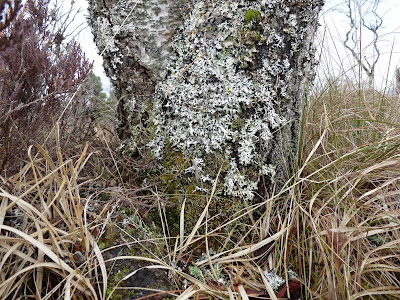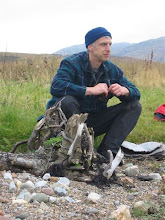











So what is all this about fluff. Well the Rannoch Brindled Beauty is a rare moth. Flanders Moss is the southerly edge of it is range that spreads north through the central highlands to Inverness. The degree of its rareness is described as Nationally Scarce A. Officially this means that it has only been recorded in between 16 and 30 10km squares since 1980. It was first recorded on Rannoch Moor in 1871 hence its name, its Latin name is Lycia lapponnaria scotica which apparently means wolf-like and refers to its shaggy body but this thick coat is more about keeping warm when the adults are out in the cool early spring. Flanders Moss is fairly typical habitat as it likes boggy moorland and heathland especially where its caterpillar food plants, bog myrtle and heather species, are found.
The adults hatch out in spring, the female has no wings (and looks like a bit of fluff) so just crawls up a fencepost or tree trunk and pumps out pheromones (chemicals) to attract in a winged male. Once they have mated the female climbs back down and searches for the dry flower heads of heather species and bog myrtle where she lays up to 150 greenish yellow eggs. The caterpillars hatch in May and eat their food plant until about August when they climb down and burrow underground to pupate. The pupal stage can last up to 4 years while the caterpillar breakdown into a moth soup before reforming as an adult moth. So the adult phase of the life cycle is only a blip compared with the prolonged larval stages.
But there is still much to be found out about this moths life at Flanders. We still haven't plotted its complete distribution on the moss. We also don't know exactly what its food plant preference is and if it has any other special requirements. For instance how important are trees to it ? All the moths recorded have been found on trees but is this only a fraction of the moths that are present ? As much of our management on Flanders is about removing trees from the Moss to keep the bog wet this is an important question to answer as we want to continue to host this special moth as we work to restore the wet bog of the past.

 9 April) I thought
9 April) I thought

 But things are happening. Even as I drove down the track to the boardwalk a wheatear flitted off the track onto a fencepost, its just passing through on the way north, and more unusual, a cuckoo swooped across the track onto the Moss - a good few days earlier than normal. Once at the car park the willow warblers had also arrived and were yelling at the top of their voices, curlews were bubbling in the fields next to the moss, the carrion crow was sitting on its nest and the common gulls had reached a gaggle of 20+ on the pool by the seat. Plant life was magically bubbling up from the dead moss surface, cotton grass flowers stuck up like a rack of spears and in one place a small patch of wood anemones showed. These give a hint of a past wooded spring landscape long gone. Spring is in full swing, if you blink you'll miss it.
But things are happening. Even as I drove down the track to the boardwalk a wheatear flitted off the track onto a fencepost, its just passing through on the way north, and more unusual, a cuckoo swooped across the track onto the Moss - a good few days earlier than normal. Once at the car park the willow warblers had also arrived and were yelling at the top of their voices, curlews were bubbling in the fields next to the moss, the carrion crow was sitting on its nest and the common gulls had reached a gaggle of 20+ on the pool by the seat. Plant life was magically bubbling up from the dead moss surface, cotton grass flowers stuck up like a rack of spears and in one place a small patch of wood anemones showed. These give a hint of a past wooded spring landscape long gone. Spring is in full swing, if you blink you'll miss it. 


 This rare species and habitat monitoring is not always what it is cut out to be. Last week I was out on the Moss monitoring the water levels in the peat. This means an 8 hour, 12 mile slog in a big circle around the bog visiting all 22 water measuring devices to see how wet the Moss is and how weel our "making the bog wetter work " is going. As it was the right time of year I decided to check for one of our rarest moths, the Rannoch Brindled Beauty. This moth is an early one coming out of its pupae in March and April to meet up, mate and lay its eggs on bog myrtle. As it is a cold time of year the moth wears a thick furry coat to keep warm. The males have a fetching grey and orange mottled look that matches perfectly the base of the birch trees where they sit waiting for a warmer day. All the females have to do is crawl from the ground where they have pupated up a nearby birch tree and wait for a male to turn up. For this they don't need wings and so don't have any. However this means that with their thick fur coat they look very like a small bit of belly button fluff . So you can imagine the job, looking for a bit of fluff about 1 cm long on the base of trees across a nature rerserve the size of 2200 football pitches. And I didn't find any ! The pay back came in the form of a pine beauty moth and 3 golden horns moths, both common species but still beautiful. And the base of birch trees are not too shaby on the moss being encrusted with lichens and algae. But after 12 miles on the bog I was walking a bit funny the next day.
This rare species and habitat monitoring is not always what it is cut out to be. Last week I was out on the Moss monitoring the water levels in the peat. This means an 8 hour, 12 mile slog in a big circle around the bog visiting all 22 water measuring devices to see how wet the Moss is and how weel our "making the bog wetter work " is going. As it was the right time of year I decided to check for one of our rarest moths, the Rannoch Brindled Beauty. This moth is an early one coming out of its pupae in March and April to meet up, mate and lay its eggs on bog myrtle. As it is a cold time of year the moth wears a thick furry coat to keep warm. The males have a fetching grey and orange mottled look that matches perfectly the base of the birch trees where they sit waiting for a warmer day. All the females have to do is crawl from the ground where they have pupated up a nearby birch tree and wait for a male to turn up. For this they don't need wings and so don't have any. However this means that with their thick fur coat they look very like a small bit of belly button fluff . So you can imagine the job, looking for a bit of fluff about 1 cm long on the base of trees across a nature rerserve the size of 2200 football pitches. And I didn't find any ! The pay back came in the form of a pine beauty moth and 3 golden horns moths, both common species but still beautiful. And the base of birch trees are not too shaby on the moss being encrusted with lichens and algae. But after 12 miles on the bog I was walking a bit funny the next day.



